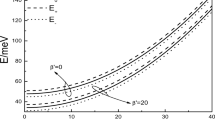Abstract
By employing a variational method of the Pekar-type, which has different variational parameters in the x–y plane and the z-direction, we study the ground and the first excited state energies and transition frequency between the ground and the first excited states of a strong-coupling polaron in an anisotropic quantum dot (AQD) under an applied magnetic field along the z-direction. The effects of the magnetic field and the electron–phonon coupling strength are taken into account. It is found that the ground and the first excited state energies and the transition frequency are increasing functions of the external applied magnetic field. The ground state and the first excited state energies are decreasing functions, whereas transition frequency is an increasing function of the electron–phonon coupling strength. We find two ways of tuning the state energies and the transition frequency: by adjusting (1) the magnetic field and (2) the electron–phonon coupling strength.



Similar content being viewed by others
References
N H Bonadeo, J Erland, D Gammon, D Park, D S Katzer and D G Steel, Science 282, 1473 (1998)
Y Nakamura, Y A Pashkin and J S Tsai, Nature 398, 786 (1999)
A N Korotkov and A N Selective, Phys. Rev. B 63, 115403 (2001)
J M Martinis, S Nam, J Aumentado and C Urbina, Phys. Rev. Lett. 89, 117901 (2002)
Y Tokura, W G van der Wiel, T Obata and S Tarucha, Phys. Rev. Lett. 96, 047202 (2006)
S M De Vasconcellos, S Gordon, M Bichler, T Meier and A Zrenner, Nat. Photon. 4, 545 (2010)
S S Li, G L Long, F S Bai, S L Feng and H Z Zheng, Proc. Natl. Acad. Sci. USA 98, 11847 (2001)
S S Li, J B Xia, J L Liu, F H Yang, Z C Niu, S L Feng and H Z Zheng, J. Appl. Phys. 90, 6151 (2001)
J L Xiao, Mod. Phys. Lett. B 26, 1250068 (2012)
S S Li and J B Xia, Appl. Phys. Lett. 91, 092119 (2007)
A L Vartanian, L A Vardanyan and E M Kazaryan, Physica E 40, 1513 (2008)
P Kaczmarkiewicz and P Machnikowski, Phys. Rev. B 81, 115317 (2010)
Z X Yu and Z Y Jiao, Int. J. Theor. Phys. 49, 652 (2010)
N K Datta and M Ghosh, Eur. Phys. J. B 80, 95 (2011)
K M Kumar, A J Peter and C W Lee, Superlatt. Microstruct. 51, 184 (2012)
R Khordad, Superlatt. Microstruct. 54, 7 (2013)
W Xiao and J L Xiao, Int. J. Mod. Phys. B 25, 3485 (2011)
L D Landau and S I Pekar, Zh. Eksp. Teor. Fiz. 16, 341 (1946)
S I Pekar, Untersuchungen über die Elektronen-theorie der Kristalle (Akademie Verlag, Berlin, 1954)
J El Khamkhami, E Feddi, E Assaid, F Dujardin, B Stebe and M El Haouari, Physica E 25, 366 (2005)
A L Vartanian, M A Yeranosyan and A A Kirakosyan, Physica B 390, 256 (2007)
W F Xie, Superlatt. Microstruc. 50, 91 (2011)
J L Xiao, J. Low. Temp. Phys. 168, 297 (2012)
C Y Chen and P W Jin, Phys. Rev. B 48, 15905 (1993)
B S Kandemir and A Cetin, J. Phys.: Condens. Matter 17, 667 (2005)
V L Nguyen, M T Nguyen and T D Nguyen, Physica B 292, 153 (2000)
C S Wang and J L Xiao, Mod. Phys. Lett. B 26, 1150003 (2012)
Y Lepine and G Bruneau, J. Phys.: Condens. Matter 10, 1495 (1998)
B S Kandemir and T Altanhan, Eur. Phys. J. B 33, 227 (2003)
Acknowledgement
This project was supported by the National Science Foundation of China under Grant No. 10964005.
Author information
Authors and Affiliations
Corresponding author
Rights and permissions
About this article
Cite this article
XIAO, W., XIAO, JL. Magnetic field effect on state energies and transition frequency of a strong-coupling polaron in an anisotropic quantum dot. Pramana - J Phys 81, 865–871 (2013). https://doi.org/10.1007/s12043-013-0614-4
Received:
Revised:
Accepted:
Published:
Issue Date:
DOI: https://doi.org/10.1007/s12043-013-0614-4




